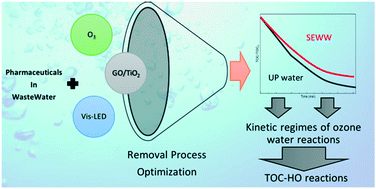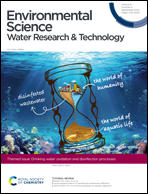On the role of a graphene oxide/titania catalyst, visible LED and ozone in removing mixtures of pharmaceutical contaminants from water and wastewater†
Abstract
A mixture of eight contaminants of emerging concern (CECs), most of them of pharmaceutical origin: acetaminophen, antipyrine, caffeine, hydrochlorothiazide, sulfamethoxazole, ketorolac, metoprolol and diclofenac, has been treated with some advanced oxidation processes (AOPs) involving ozone, visible LED radiation and a graphene oxide/titania catalyst (GO/TiO2). Variables that affect the process rate: visible LED radiation fluence, catalyst concentration and percentage of graphene oxide on the catalyst, were optimized through a factorial design taking TOC as an objective function. These variables were found to be: 303 W m−2, 0.4 g L−1, 1.5% GO loading, respectively, and tested in CEC doped wastewater. Application of gas–liquid absorption kinetics allows the kinetic regime of ozone reactions and the relative importance of mass transfer and chemical reactions to be determined. Two reaction periods were observed: an initial one of less than 20 minutes, where contaminants are removed mainly through direct reactions with ozone, and a second one, where free radical oxidation predominates. In this second period, hydroxyl radical concentrations for ozonation and photocatalytic ozonation were found to be 1.1 and 3.2 × 10−13 M, respectively.

- This article is part of the themed collection: Drinking water oxidation and disinfection processes


 Please wait while we load your content...
Please wait while we load your content...